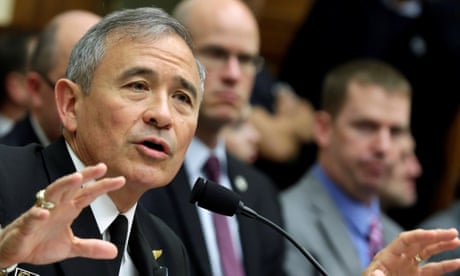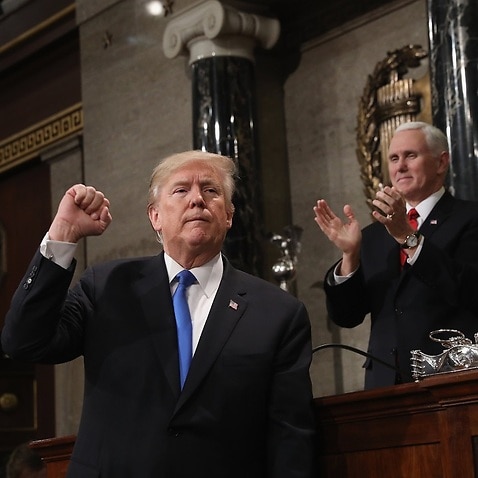The coming war on China | New Internationalist
The coming war on China

A major US military build-up – including nuclear weapons – is under way in Asia and the Pacific with the purpose of confronting China. John Pilger raises the alarm on an under-reported and dangerous provocation.
NI 498 - December, 2016
Features
China
United States

Preparing for conflict: guided-missile destroyer USS McCampbell patrolling in the South China Sea earlier this year.
Photo: US Navy
When I first went to Hiroshima in 1967, the shadow on the steps was still there. It was an almost perfect impression of a human being at ease: legs splayed, back bent, one hand by her side as she sat waiting for a bank to open. At a quarter past eight on the morning of 6 August, 1945, she and her silhouette were burned into the granite. I stared at the shadow for an hour or more, unforgettably. When I returned many years later, it was gone: taken away, ‘disappeared’, a political embarrassment.
I have spent two years making a documentary film, The Coming War on China, in which the evidence and witnesses warn that nuclear war is no longer a shadow, but a contingency. The greatest build-up of American-led military forces since the Second World War is well under way. They are on the western borders of Russia, and in Asia and the Pacific, confronting China.
The great danger this beckons is not news, or it is news buried and distorted: a drumbeat of propaganda that echoes the psychopathic campaign embedded in public consciousness during much of the 20th century.
Like the renewal of post-Soviet Russia, the rise of China as an economic power is declared an ‘existential threat’ to the divine right of the United States to rule and dominate human affairs.
To counter this, in 2011 President Obama announced a ‘pivot to Asia’, which meant that almost two-thirds of US naval forces would be transferred to Asia and the Pacific by 2020.
Today, more than 400 American military bases encircle China with missiles, bombers, warships and, above all, nuclear weapons. From Australia north through the Pacific to Japan, Korea and across Eurasia to Afghanistan and India, the bases form, says one US strategist, ‘the perfect noose’.
A study by the RAND Corporation – which, since Vietnam, has planned America’s wars – is entitled War with China: Thinking Through the Unthinkable. Commissioned by the US Army, the authors evoke the Cold War when RAND made notorious the catch cry of its chief strategist, Herman Kahn – ‘thinking the unthinkable’. Kahn’s book, On Thermonuclear War, elaborated a plan for a ‘winnable’ nuclear war against the Soviet Union.
Today, his apocalyptic view is shared by those holding real power in the US: the Pentagon militarists and their neoconservative collaborators in the executive, intelligence agencies and Congress. The current Secretary of Defense, Ashley Carter, a verbose provocateur, says US policy is to confront those ‘who see America’s dominance and want to take that away from us’.

Today, more than 400 American military bases encircle China with missiles, bombers, warships and nuclear weapons.
Photo: Charles Gatward: The Coming War on China, Darmouth Films
'Punish' China
In Washington, I met Amitai Etzioni, distinguished professor of international affairs at George Washington University. The US, he writes, ‘is preparing for a war with China, a momentous decision that so far has failed to receive a thorough review from elected officials, namely the White House and Congress.’
This war would begin with a ‘blinding attack against Chinese anti-access facilities, including land and sea-based missile launchers… satellite and anti-satellite weapons’. The incalculable risk is that ‘deep inland strikes could be mistakenly perceived by the Chinese as pre-emptive attempts to take out its nuclear weapons, thus cornering them into “a terrible use-it-or-lose-it dilemma” [that would] lead to nuclear war.’
In 2015, the Pentagon released its Law of War Manual. ‘The United States,’ it says, ‘has not accepted a treaty rule that prohibits the use of nuclear weapons per se, and thus nuclear weapons are lawful weapons for the United States.’
In China, a strategist told me, ‘We are not your enemy, but if you [in the West] decide we are, we must prepare without delay.’ China’s military and arsenal are small compared to America’s. However, ‘for the first time,’ wrote Gregory Kulacki of the Union of Concerned Scientists, ‘China is discussing putting its nuclear missiles on high alert so that they can be launched quickly on warning of an attack… This would be a significant and dangerous change in Chinese policy… Indeed, the nuclear weapon policies of the United States are the most prominent external factor influencing Chinese advocates for raising the alert level of China’s nuclear forces.’
'I don't want it to be a fair fight. If it's a knife fight, I want to bring a gun'
Professor Ted Postol was scientific adviser to the head of US naval operations. An authority on nuclear weapons, he told me, ‘Everybody here wants to look like they’re tough. See, I got to be tough… I’m not afraid of doing anything military, I’m not afraid of threatening; I’m a hairy-chested gorilla. And we have gotten into a state, the United States has gotten into a situation where there’s a lot of sabre-rattling, and it’s really being orchestrated from the top.’
I said, ‘This seems incredibly dangerous.’
‘That’s an understatement.’
Andrew Krepinevich is a former Pentagon war planner and the influential author of war games against China. He wants to ‘punish’ China for extending its defences to the South China Sea. He advocates seeding the ocean with sea mines, sending in US special forces and enforcing a naval blockade. He told me, ‘Our first president, George Washington, said if you want peace, prepare for war.’
In 2015, in high secrecy, the US staged its biggest single military exercise since the Cold War. This was Talisman Sabre; an armada of ships and long-range bombers rehearsed an ‘Air-Sea Battle Concept for China’ – ASB – blocking sea lanes in the Straits of Malacca and cutting off China’s access to oil, gas and other raw materials from the Middle East and Africa.

Nerje Joseph, a survivor of nuclear tests on the MarshallIslands between 1946-58, holds a picture of the blast injuries she sustained as a child.
Photo: Bruno Sorrentino and John Pilger
It is such a provocation, and the fear of a US Navy blockade, that has seen China feverishly building strategic airstrips on disputed reefs and islets in the Spratly Islands in the South China Sea. Last July, the UN Permanent Court of Arbitration ruled against China’s claim of sovereignty over these islands. Although the action was brought by the Philippines, it was presented by leading American and British lawyers and can be traced to then US Secretary of State Hillary Clinton.
In 2010, Clinton flew to Manila. She demanded that America’s former colony reopen the US military bases closed down in the 1990s following a popular campaign against the violence they generated, especially against Filipino women. She declared China’s claim on the Spratly Islands – which lie more than 7,500 miles (12,000 kilometres) from the United States – a threat to US ‘national security’ and to ‘freedom of navigation’.
Handed millions of dollars in arms and military equipment, the then government of President Benigno Aquino broke off bilateral talks with China and signed a secretive Enhanced Defense Co-operation Agreement with the US. This established five rotating US bases and restored a hated colonial provision that American forces and contractors were immune from Philippine law.
Under the rubric of ‘information dominance’ – the jargon for media manipulation on which the Pentagon spends more than $4 billion – the Obama administration launched a propaganda campaign that cast China, the world’s greatest trading nation, as a threat to ‘freedom of navigation’.
CNN led the way, its ‘national security reporter’ reporting excitedly from on board a US Navy surveillance flight over the Spratlys. The BBC persuaded frightened Filipino pilots to fly a single-engine Cessna over the disputed islands ‘to see how the Chinese would react’. None of the news reports questioned why the Chinese were building airstrips off their own coastline, or why American military forces were massing on China’s doorstep.
The designated chief propagandist is Admiral Harry Harris, the US military commander in Asia and the Pacific. ‘My responsibilities,’ he told The New York Times, ‘cover Bollywood to Hollywood, from polar bears to penguins.’ Never was imperial domination described as pithily.
Malleable media and obsequious partners
Harris is one of a brace of Pentagon admirals and generals briefing selected, malleable journalists and broadcasters, with the aim of justifying a threat as specious as that with which George W Bush and Tony Blair justified the destruction of Iraq.
In Los Angeles in September, Harris declared he was ‘ready to confront a revanchist Russia and an assertive China… If we have to fight tonight, I don’t want it to be a fair fight. If it’s a knife fight, I want to bring a gun. If it’s a gun fight, I want to bring in the artillery… and all our partners with their artillery.’
These ‘partners’ include South Korea, an American colony in all but name and the launch pad for the Pentagon’s Terminal High Altitude Air Defense system, known as THAAD, ostensibly aimed at North Korea. As Professor Postol points out, it targets China.
In Sydney, Australia, Harris called on China to ‘tear down its Great Wall in the South China Sea’. The imagery was front-page news. Australia is America’s most obsequious ‘partner’; its political elite, military, intelligence agencies and the dominant Murdoch media are fully integrated into what is known as the ‘alliance’. Closing the Sydney Harbour Bridge for the motorcade of a visiting American government ‘dignitary’ is not uncommon. The war criminal Dick Cheney was afforded this honour.
Although China is Australia’s biggest trader, on which much of the national economy relies, ‘confronting China’ is the diktat from Washington. The few political dissenters in Canberra risk McCarthyite smears in the Murdoch press. ‘You in Australia are with us come what may,’ said one of the architects of the Vietnam War, McGeorge Bundy. One of the most important US bases is Pine Gap near Alice Springs. Founded by the CIA, it spies on China and all of Asia, and is a vital contributor to Washington’s murderous war by drone in the Middle East.
In October, Richard Marles, the defence spokesperson of the main Australian opposition party, the Labor Party, demanded that ‘operational decisions’ in provocative acts against China be left to military commanders in the South China Sea. In other words, a decision that could mean war with a nuclear power should not be taken by an elected leader or a parliament but by an admiral or a general.
This is the Pentagon line, a historic departure for any state calling itself a democracy. The ascendancy of the Pentagon in Washington – which Daniel Ellsberg has called a silent coup – is reflected in the record $5 trillion the United States has spent on aggressive wars since 9/11, according to a study by Brown University. The million dead in Iraq and the flight of 12 million refugees from at least four countries are the consequence.
‘I state clearly and with conviction,’ said Obama in 2009, ‘America’s commitment to seek the peace and security of a world without nuclear weapons.’ Under Obama, nuclear warhead spending has risen higher than under any president since the end of the Cold War. A mini nuclear weapon is planned. Known as the B61 Model 12, it will mean, says General James Cartwright, former vice-chair of the Joint Chiefs of Staff, that ‘going smaller [makes its use] more thinkable’.
‘The China trade’
James Bradley is the author of the best-selling The China Mirage: The Hidden History of American Disaster in Asia (Little Brown, 2015). In these excerpts from his interview with John Pilger, he describes how modern America was built on the ‘China trade’.
James Bradley: For most of American history, it was illegal for someone like me to know a Chinese. The Chinese came to America to mine gold and build the railroads, and Americans decided we didn’t like competition. So in 1882 we had the Chinese Exclusion Acts, which kept the Chinese out of the United States for about 100 years. Just at the point we were putting up the Statue of Liberty saying we welcome everybody, we were erecting a wall saying: ‘We welcome everybody except those Chinese.’
John Pilger: And yet, for the American elite in the 19th century, China was a goldmine.
JB: A goldmine of drugs. Warren Delano, the grandfather of Franklin Delano Roosevelt, was the American opium king of China; he was the biggest American opium dealer, second only to the British. Much of the east coast [establishment] of the United States – Columbia, Harvard, Yale, Princeton – was born of drug money. The American industrial revolution was funded by huge pools of money – where did this come from? It came from illegal drugs in the biggest market in the world: China.
JP: So the grandfather of the most liberal president, Franklin Delano Roosevelt, was a drug runner?
JB: Yes. Franklin Delano Roosevelt never made much money in his life. He had public-service jobs that were very lowly paid, but he inherited a fortune from Warren Delano, his father. Now if you scratch anyone with the name Forbes, you’ll find opium money… such as John Forbes Kerry…
JP: That’s the present Secretary of State.
JB: Yes. His great-grandfather [Francis Blackwell Forbes] was an opium dealer. How big was opium money? Opium money built the first industrial city in the United States. It built the first five railroads. But it wasn’t talked about. It was called the China trade.

In 1959 a US fighter plane crashed into Miyamori School, Okinawa, killing a number of children.
Peaceful resistance
The Japanese island of Okinawa has 32 military installations, from which Korea, Vietnam, Cambodia, Afghanistan and Iraq have been attacked by the United States. Today, the principal target is China, with whom Okinawans have close cultural and trade ties.
There are military aircraft constantly in the sky over Okinawa; they sometimes crash into homes and schools. People cannot sleep, teachers cannot teach. Wherever they go in their own country, they are fenced in and told to keep out.
A hugely popular Okinawan movement has been growing since a 12-year-old girl was gang-raped by US troops in 1995. It was one of hundreds of such crimes, many of them never prosecuted. Barely acknowledged in the wider world, the resistance in Okinawa is a vivid expression of how ordinary people can peacefully take on a military giant, and threaten to win.
Their campaign has elected Japan’s first anti-base governor, Takeshi Onaga, and presented an unfamiliar hurdle to the Tokyo government and the ultra-nationalist Prime Minister Shinzo Abe’s plans to repeal Japan’s ‘peace constitution’.
The resistance leaders include Fumiko Shimabukuro, aged 87, a survivor of the Second World War, when a quarter of Okinawans died in the American invasion. Fumiko and hundreds of others took refuge in beautiful Henoko Bay, which she is now fighting to save. The US wants to destroy the bay in order to extend runways for its bombers. As we gathered peacefully outside the US base, Camp Schwab, giant Sea Stallion helicopters hovered over us for no reason other than to intimidate.

Fumiko Shimabukuro (right), an Okinawa World War Two survivor, is now fighting to save a bay from US bombers. With her is Eiko Ginoza.
Photo: Bruno Sorrentino and John Pilger
Across the East China Sea lies the Korean island of Jeju, a semi-tropical sanctuary and World Heritage Site declared ‘an island of world peace’. On this island of world peace has been built one of the most provocative military bases in the world, less than 400 miles (650 kilometres) from Shanghai. The fishing village of Gangjeong is dominated by a South Korean naval base purpose-built for US aircraft carriers, nuclear submarines and destroyers equipped with the Aegis missile system, aimed at China.
A people’s resistance to these war preparations has become a presence on Jeju for almost a decade. Every day, often twice a day, villagers, Catholic priests and supporters from all over the world stage a religious mass that blocks the gates of the base. In a country where political demonstrations are often banned, unlike powerful religions, the tactic has produced an inspiring spectacle.
The world is shifting east, but the astonishing vision of Eurasia from China is barely understood in the West
One of the leaders, Father Mun Jeong-hyeon, told me, ‘I sing four songs every day at the base, regardless of the weather. I sing in typhoons – no exception. To build this base, they destroyed the environment, and the life of the villagers, and we should be a witness to that. They want to rule the Pacific. They want to make China isolated in the world. They want to be emperor of the world.’

South Korean woodcarver and Catholic priest, Father Mun Jeong-hyeon, leads a daily protest against the building of a naval base that the US will use to target China.
Photo: Bruno Sorrentino and John Pilger
I flew to Shanghai for the first time in more than a generation. When I was last in China, the loudest noise I remember was the tinkling of bicycle bells; Mao Zedong had recently died, and the cities seemed dark places, in which foreboding and expectation competed. Within a few years, Deng Xiaoping, the ‘man who changed China’, was the ‘paramount leader’. Nothing prepared me for the astonishing changes today.
I met Lijia Zhang, a Beijing journalist and typical of a new class of outspoken mavericks. Her best-selling book has the ironic title Socialism Is Great! She grew up during the chaotic and brutal Cultural Revolution and has lived in the US and Europe. ‘Many Americans imagine,’ she said, ‘that Chinese people live a miserable, repressed life with no freedom whatsoever. The [idea of] the yellow peril has never left them… They have no idea there are some 500 million people being lifted out of poverty, and some would say it’s 600 million.’

China today: a tourist snaps the bull of capitalism in front of Shanghai’s Bund hotel, bedecked with communist flags.
Photo: Bruno Sorrentino and John Pilger
She described modern China as a ‘golden cage’. ‘Since the reforms started,’ she said, ‘and we’ve become so much better off, China has become one of the most unequal societies in the world. There are lots of protests now: typically, land being grabbed by officials for commercial development. But farmers are more aware of their rights; and young factory workers are demanding a better wage and conditions.’
The world is shifting east
China today presents perfect ironies, not least the house in Shanghai where Mao and his comrades secretly founded the Communist Party of China in 1921. Today, it stands in the heart of a very capitalist shopping district; you walk out of this communist shrine with your Little Red Book and your plastic bust of Mao into the embrace of Starbucks, Apple, Cartier, Prada.
Would Mao be shocked? I doubt it. Five years before his great revolution in 1949, he sent this secret message to Washington. ‘China must industrialize,’ he wrote. ‘This can only be done by free enterprise. Chinese and American interests fit together, economically and politically. America need not fear that we will not be co-operative. We cannot risk any conflict.’
Mao offered to meet Franklin Roosevelt in the White House, and his successor Harry Truman, and his successor Dwight Eisenhower. He was rebuffed, or wilfully ignored. The opportunity that might have changed contemporary history, prevented wars in Asia and saved countless lives was lost because the truth of these overtures was denied in 1950s Washington ‘when the catatonic Cold War trance,’ wrote the critic James Naremore, ‘held our country in its rigid grip’.
Eric Li, a Shanghai venture capitalist and social scientist, told me, ‘I make the joke: in America you can change political parties, but you can’t change the policies. In China you cannot change the party, but you can change policies. The political changes that have taken place in China this past 66 years have been wider and broader and greater than probably in any other major country in living memory.’

Beijing journalist and outspoken maverick, Lijia Zhang.
For all the difficulties of those left behind by China’s rapid growth, such as workers from the countryside living on the edge in cities built for conspicuous consumption, and those Tiananmen brave-hearts still challenging ‘the centre’, the Party, what is striking is the widespread sense of optimism that buttresses the epic of change.
The world is shifting east; but the astonishing vision of Eurasia from China is barely understood in the West. The ‘New Silk Road’ is a ribbon of trade, ports, pipelines and high-speed trains all the way to Europe. China, the world’s leader in rail technology, is negotiating with 28 countries for routes on which trains will reach up to 400 kilometres an hour. This opening to the world has the approval of much of humanity and, along the way, is uniting China and Russia; and they are doing it entirely without ‘us’ in the West.
We – or many of us – remain in thrall to the US, which has intervened violently in the affairs of a third of the members of the United Nations, destroying governments, subverting elections, imposing blockades. In the past five years, the US has shipped deadly weapons to 96 countries, most of them poor. Dividing societies in order to control them is US policy, as the tragedies in Iraq and Syria demonstrate.
‘I believe in American exceptionalism with every fibre of my being,’ said Barack Obama, evoking the national fetishism of the 1930s. This modern cult of superiority is Americanism, the world’s dominant predator. Accompanied by a brainwashing that presents it as enlightenment on the march, the conceit insinuates our lives.
In September, the Atlantic Council, a US geopolitical thinktank, published a report that predicted a Hobbesian world ‘marked by the breakdown of order, violent extremism [and] an era of perpetual war’. The new enemies were a ‘resurgent’ Russia and an ‘increasingly aggressive’ China. Only heroic America can save us.
There is a demented quality about this war-mongering. It is as if the ‘American Century’ – proclaimed in 1941 by the American imperialist Henry Luce, owner of Time magazine – has ended without notice and no-one has had the courage to tell the emperor to take his guns and go home.
John Pilger

Protesters on Jeju, South Korea.
Photo: Bruno Sorrentino and John Pilger
The coming war on China

John Pilger's documentary, The Coming War on China, is in cinemas in the UK from 1 December, beginning at the BFI on London’s Southbank. On 5 December, Picturehouse cinemas will hold a nationwide with John Pilger. The website is picturehouses.com. On 6 December, ITV will broadcast the film and a DVD will be available the same day. The Australian release is early in 2017; SBS Australia will broadcast the film nationwide.
For worldwide distribution enquiries, contact Dartmouth Films: christo@dartmouthfilms.com. The film’s website address is thecomingwarmovie.com






